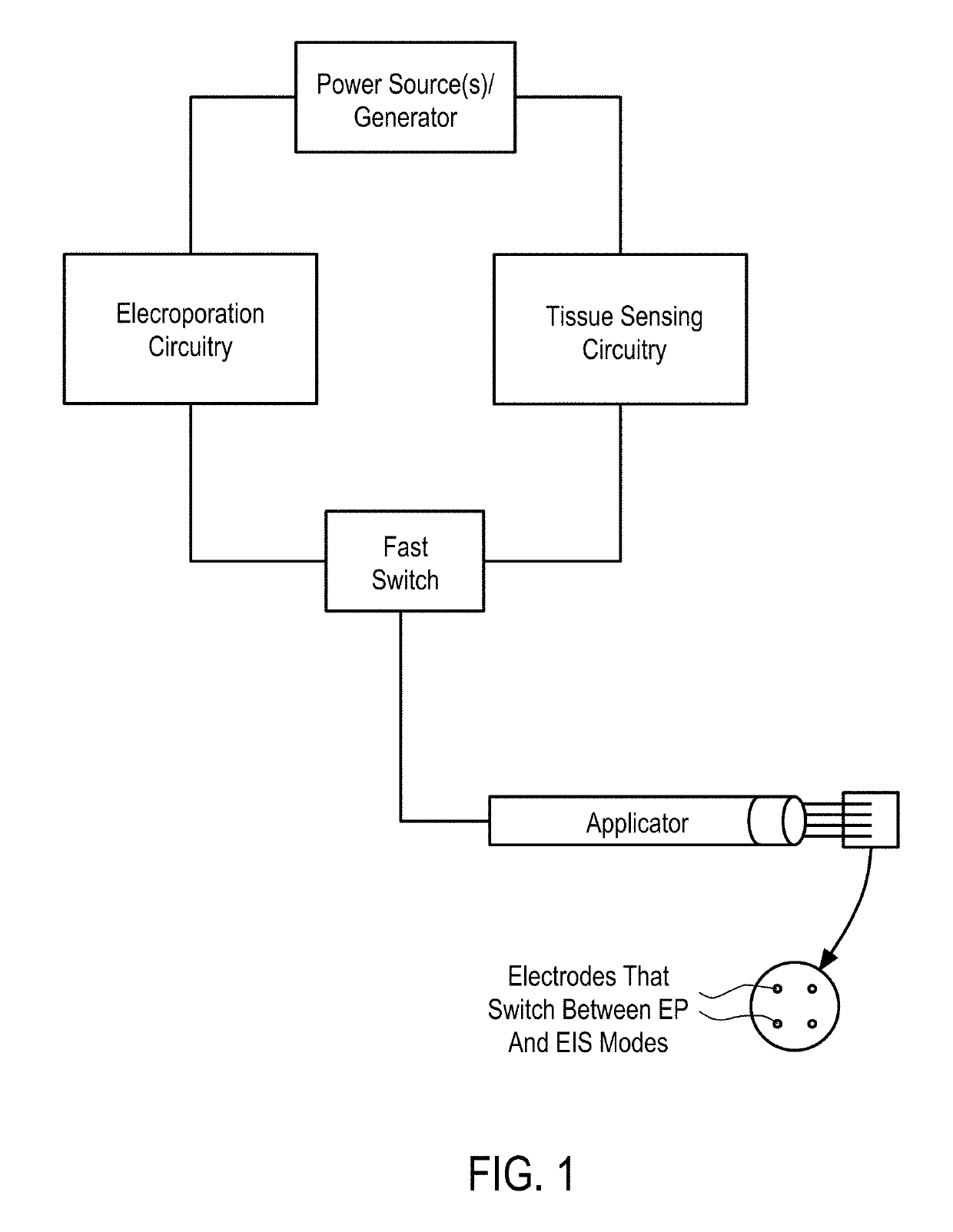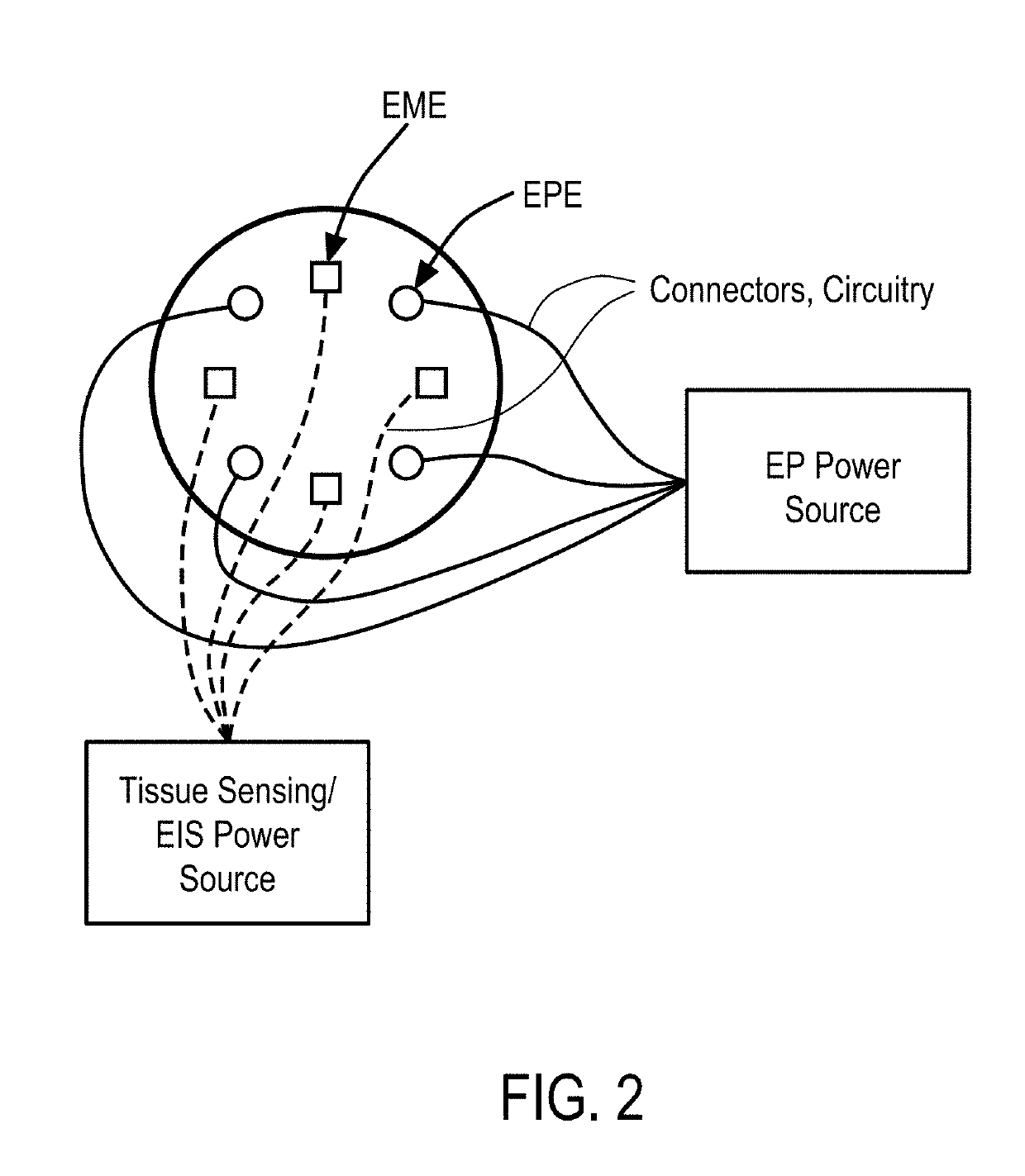Systems and Methods for Improved Tissue-Sensing Based Electroporation
- Summary
- Abstract
- Description
- Claims
- Application Information
AI Technical Summary
Benefits of technology
Problems solved by technology
Method used
Image
Examples
example 1
[0413]OncoSec built an EP generator A, illustrated in FIG. 16, capable of performing real-time feedback control based on EIS data before and between each EP pulse. This system can output a minimum of 10V and maximum of 300 V with pulse durations ranging from 100 s to 10 ms. EIS data captured before and between pulses is obtained over a range of 100 Hz to 10 kHz with 10 data points acquired per decade. Acquisition of EIS data over this spectra is accomplished in 250 ms, which is rapid enough to: (1) execute routines to determine a time constant for the next pulse; (2) store EIS data for post analysis; and (3) not interrupt clinically used EP conditions. Data gathered from the EIS system is fit to the tissue impedance model, described above, in real-time using an embedded Advanced RISC Machine (ARM) microprocessor (STM32F407, ST Microelectronics). When operating in feedback mode, features of this data can be used to control parameters associated with the EP process. The custom generat...
example 2
[0418]An experiment was performed to determine if electrochemical impedance spectroscopy (EIS) could differentiate between data acquired in fibrotic or necrotic tissues from data acquired in healthy tissues. In these experiments, livers of 9-month-old transgenic mice expressing human platelet derived growth factor C (PDGF-C) were used to represent fibrotic tissues. By this age PDGF-C transgenic mice are known to have enlarged livers with significant fibrosis, fat infiltrate, and cell dysplasia. Data acquired from livers of transgenic animals was compared to healthy, or wild type, 3-month-old C57Bl / 6J livers. To acquire this data mice were anesthetized to allow surgical access to the liver. Parallel electrodes, spaced 3 mm apart, were inserted 5 mm into the left lateral lobe of the liver. Data collected from this experiment was fit to a constant phase element model used to electrically represent biological tissues. Parameters derived from the model fit revealed liver fibrosis resulte...
example 3
[0419]A second experiment was performed to determine if EIS could detect the presence of an injectate in tumor tissue. In this experiment, tumors were implanted in the subcutaneous tissue on the flank skin of 8-week-old albino B6 mice by injecting 106 MC38 cells in 50 μl of phosphate buffered saline. After approximately 10 days, tumors reached an average volume of 100 mm3. At this time a two-electrode applicator with a central injection lumen was inserted 7 mm into the tumor. A baseline EIS measurement of the initial condition of the tumor was then taken. After this measurement, a volume of 50 μl of a 1 mg / ml solution of plasmid DNA prepared in physiological saline was injected into the tumor. Following injection a second EIS measurement was performed. Again these data were fit to a constant phase element model used to represent biological tissues. A drop in solution resistance of at least 10% was observed after injecting the tumor with the plasmid DNA solution. FIG. 44 provides a h...
PUM
 Login to View More
Login to View More Abstract
Description
Claims
Application Information
 Login to View More
Login to View More - R&D
- Intellectual Property
- Life Sciences
- Materials
- Tech Scout
- Unparalleled Data Quality
- Higher Quality Content
- 60% Fewer Hallucinations
Browse by: Latest US Patents, China's latest patents, Technical Efficacy Thesaurus, Application Domain, Technology Topic, Popular Technical Reports.
© 2025 PatSnap. All rights reserved.Legal|Privacy policy|Modern Slavery Act Transparency Statement|Sitemap|About US| Contact US: help@patsnap.com



